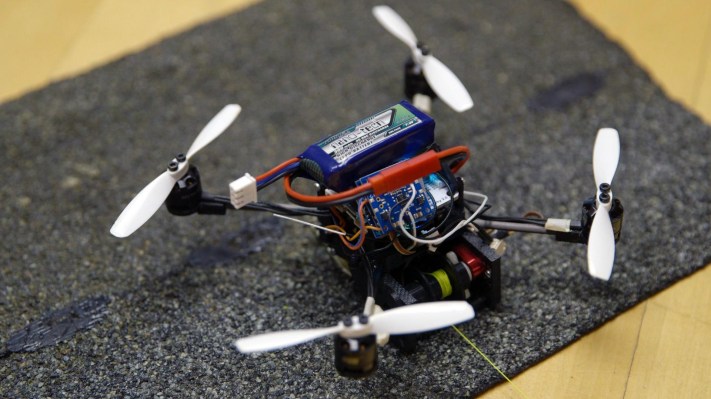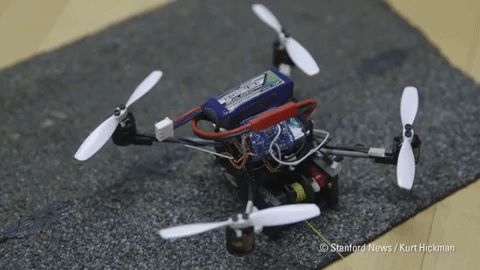If we want drones to do our dirty work for us, they’re going to need to get pretty good at hauling stuff around. But due to the pesky yet unavoidable restraints of physics, it’s hard for them to muster the forces necessary to do so while airborne — so these drones brace themselves against the ground to get the requisite torque.
The drones, created by engineers at Stanford and Switzerland’s EPFL, were inspired by wasps and spiders that need to drag prey from place to place but can’t actually lift it, so they drag it instead. Grippy feet and strong threads or jaws let them pull objects many times their weight along the ground, just as you might slide a dresser along rather than pick it up and put it down again. So I guess it could have also just been inspired by that.
Whatever the inspiration, these “FlyCroTugs” (a combination of flying, micro and tug presumably) act like ordinary tiny drones while in the air, able to move freely about and land wherever they need to. But they’re equipped with three critical components: an anchor to attach to objects, a winch to pull on that anchor and sticky feet to provide sure grip while doing so.
“By combining the aerodynamic forces of our vehicle and the interactive forces generated by the attachment mechanisms, we were able to come up with something that is very mobile, very strong and very small,” said Stanford grad student Matthew Estrada, lead author of the paper published in Science Robotics.
The idea is that one or several of these ~100-gram drones could attach their anchors to something they need to move, be it a lever or a piece of trash. Then they take off and land nearby, spooling out thread as they do so. Once they’re back on terra firma they activate their winches, pulling the object along the ground — or up over obstacles that would have been impossible to navigate with tiny wheels or feet.
Using this technique — assuming they can get a solid grip on whatever surface they land on — the drones are capable of moving objects 40 times their weight — for a 100-gram drone like that shown, that would be about 4 kilograms, or nearly 9 pounds. Not quickly, but that may not always be a necessity. What if a handful of these things flew around the house when you were gone, picking up bits of trash or moving mail into piles? They would have hours to do it.
As you can see in the video below, they can even team up to do things like open doors.
“People tend to think of drones as machines that fly and observe the world,” said co-author of the paper, EPFL’s Dario Floreano, in a news release. “But flying insects do many other things, such as walking, climbing, grasping and building. Social insects can even work together and combine their strength. Through our research, we show that small drones are capable of anchoring themselves to surfaces around them and cooperating with fellow drones. This enables them to perform tasks typically assigned to humanoid robots or much larger machines.”
Unless you’re prepared to wait for humanoid robots to take on tasks like this (and it may be a decade or two), you may have to settle for drone swarms in the meantime.

